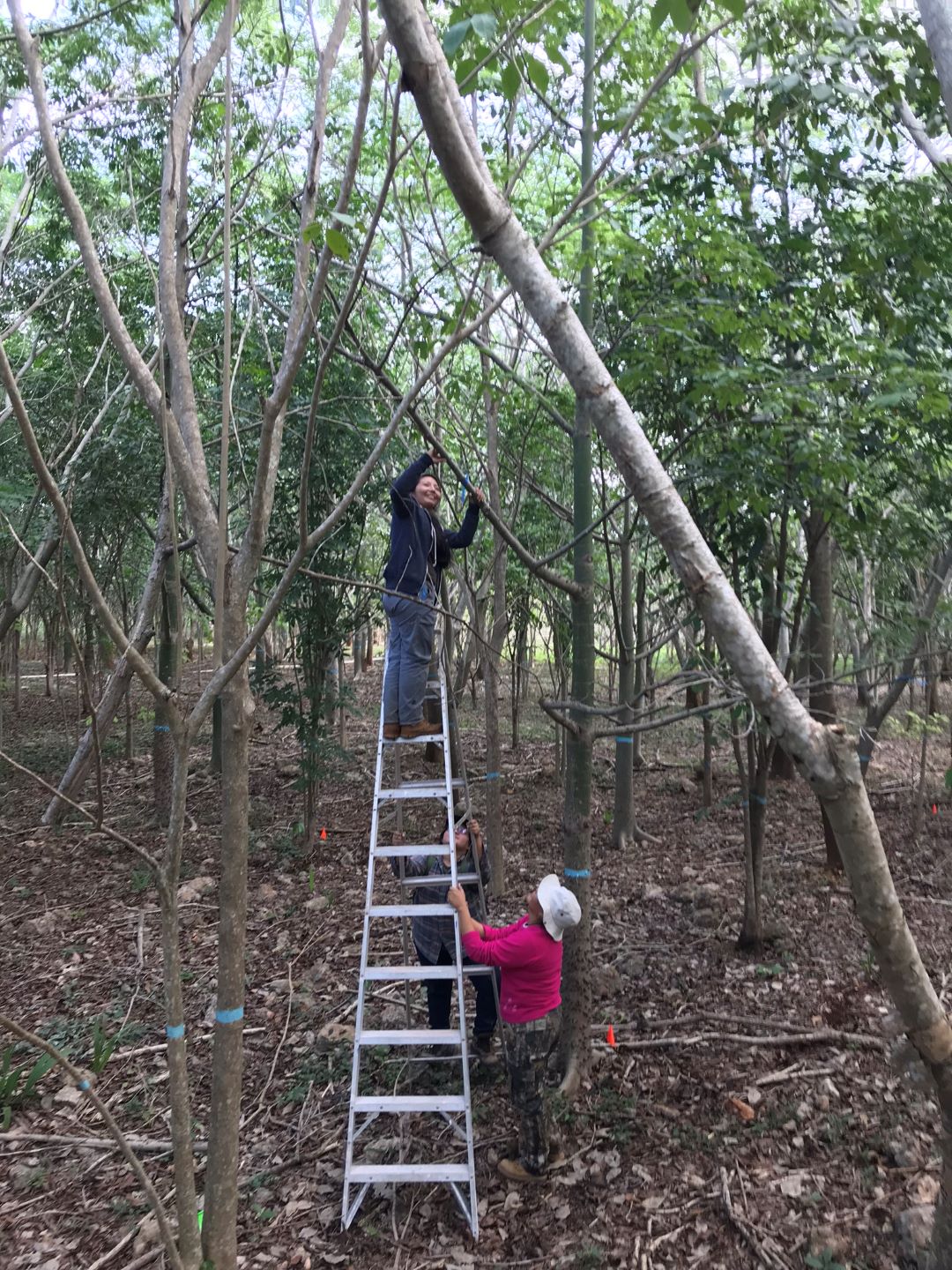UADY Tree Diversity Experiment (Mexico)
The UADY Tree Diversity Experiment was established in Yucatan, at a site owned by INIFAP (Mexican Institute for Forestry and Agriculture), in December 2011. To test for species richness effects, two types of plots were planted: monocultures and four-species mixtures. For big-leaf mahogany (Swietenia macrophylla), one of the component species, we also manipulated the number of genotypes (maternal lines) to test for effects of genotypic diversity within this species. Tree growth, functional traits, and bi- and tri-trophic interactions between trees, herbivorous arthropods, and natural enemies of these herbivores are being studied.
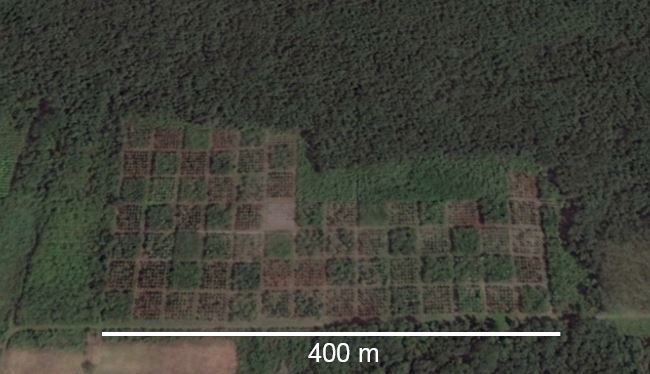
Design
The experiment consists of 74 plots of 21 m x 21 m. Monocultures (two plots per species, except for mahogany) and four-species mixtures were planted. Mahogany was planted in 59 of the 74 plots: 12 mahogany monocultures of a single maternal line or genotype (2 plots/genotype), 20 mahogany monocultures containing four mahogany genotypes, 12 four-species plots in which all mahogany saplings were of one genotype (two plots/genotype), and 15 four-species plots within which four mahogany genotypes were planted. Thus, mahogany genotypic diversity is fully crossed with tree species diversity.
The species and genotype richness treatments contain equal numbers of individuals of four species or four mahogany genotypes. In addition, all the non-mahogany species are equally represented across the four-species mixtures, with each species present in six plots. Similarly, each mahogany genotype is represented in a similar number of the four-genotype mahogany monoculture plots (8 or 9 plots per genotype). Besides, each genotype is also present in a similar number of four-species mixtures in which the four genotypes were planted together (9 or 10 plots per genotype). The plots of each diversity treatment combination were randomly distributed throughout the experimental site.
Seeds of all species were collected from adult plants in southern Quintana Roo (México) between January and March 2011. The distance among the source trees ranged from 1.5 to 50 km. Seedlings were four months old when planted.
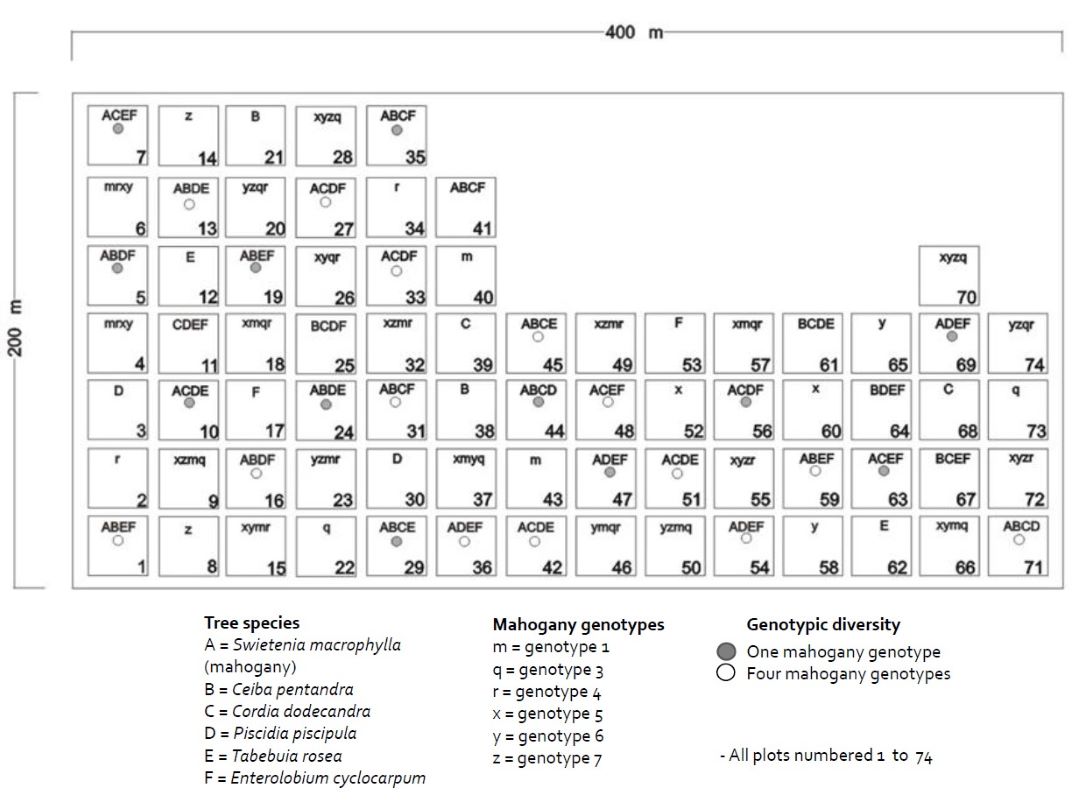
Site characteristics
| UADY (Muna) | |
|---|---|
| Country | Mexico |
| Biome | tropical |
| Latitude | 20.41 |
| Longitude | -89.75 |
| Soil type | calcic cambisols and luvisols |
| Former land use | orchard, pasture |
| Altitude | 20 m |
| Design | stem wise randomisation |
| Plot shape | square |
| Plot size (m^2) | 441 m² |
| Plant distance (m) | 3 |
| Number of trees planted | 4780 |
| Planting date | 2001 |
| Diversity variables | species richness genotype richness |
| Diversity gradient | 1, 4 sp. 1, 4 genotypes (mahogany) |
| Size species pool | 6 species 6 genotypes |
| Species pool | Ceiba pentandra Cordia dodecandra Enterolobium cyclocarpum Piscidia piscipula Swietenia macrophylla Tabebuia rosea |
| Contact person | Luis Abdala-Roberts Víctor Parra-Tabla |
| abdala.luis@yahoo.com ptabla@correo.uady.mx |
Research
The effects of tree species diversity and mahogany genotypic diversity on herbivory and parasitism associated with these herbivores are monitored from the start of the experiment. Much of this work has been centred on insect herbivores feeding on mahogany (e.g., leafhoppers, stem borers, and leaf miners) for which both diversity effects can be evaluated. In addition, diversity effects on plant functional traits (e.g., architecture, anti-herbivore defences), tree growth, and bi- and tri-trophic interactions between plants, herbivorous arthropods, and natural enemies (other arthropods and birds) of these herbivores are also investigated.
Extra information
For more information on the UADY Tree Diversity Experiment, send an e-mail to the contact person, or explore the publications that utilized data from this experiment.
Research papers
- Vázquez-González C, Castagneyrol B, Muiruri EW, Barbaro L, Abdala-Roberts L, Barsoum N, Fründ J, Glynn C, Jactel H, McShea WJ, Mereu S, Mooney KA, Morillas L, Nock CA, Paquette A, Parker JD, Parker, WC, Roales J, Scherer-Lorenzen M, Schuldt A, Verheyen K, Weih M, Yang B, Koricheva J 2024 Tree diversity enhances predation by birds but not by arthropods across climate gradients. Ecology Letters (27): e14427 - https://doi.org/10.1111/ele.14427
- Vázquez-González C, Villa-Galaviz E, Reyes-Hernández M, Perez-Niño B, Quijano-Medina T, Parra-Tabla V, Mooney KA, Abdala-Roberts L 2024 Temporal variation in tree diversity effects on birds and its implications for top-down control of insect herbivores in a tropical system. Oecologia 204(3): 603-612 - https://doi.org/10.1007/s00442-024-05514-1
- Depauw L, De Lombaerde E, Dhiedt E, Blondeel H, Abdala-Roberts L, Auge H, Barsoum N, Bauhus J, Chu C, Damtew A, Eisenhauer N, V. Fagundes M, Ganade G, Gendreau-Berthiaume B, Godbold D, Gravel D, Guillemot J, Hajek P, Hector A, Hérault B, Jactel H, Koricheva J, Kreft H, Liu X, Mereu S, Messier C, Muys B, Nock CA, Paquette A, Parker JD, Parker WC, Paterno, GB, Perring MP, Ponette Q, Potvin C, Reich PB, Rewald B, Scherer-Lorenzen M, Schnabel F, Sousa-Silva R, Weih M, Clara Zemp D, Verheyen K, Baeten L 2024 Enhancing Tree Performance Through Species Mixing: Review of a Quarter-Century of TreeDivNet Experiments Reveals Research Gaps and Practical Insights. Current Forestry Reports - https://doi.org/10.1007/s40725-023-00208-y
- FAO 2023 Towards more resilient and diverse planted forests. Unasylva (254)74: 2031/1. Rome. https://doi. org/10.4060/cc8584en
- Interián-Aguiñaga J, Parra-Tabla V, Abdala-Roberts L 2022 Effects of tropical tree diversity and prey distribution on predation by birds and arthropods. Arthropod-Plant Interactions.
- Quinto J, Díaz-Castelazo C, Rico-Gray V, Martínez-Falcón AP, Abdala-Roberts L, Parra-Tabla V 2022 Short-term temporal patterns in herbivore beetle assemblages in polyculture neotropical forest plantations. Neotropical Entomology 51: 199-211 - https://doi.org/10.1007/s13744-021-00933-8
- Villa-Galaviz E, Quinto J, Abdala-Roberts L, Parra-Tabla V 2022 Neighboring plants and core herbivores determine the importance of Swietenia macrophylla in a plant-herbivore network. Arthropod-Plant Interactions 16: 387-399 - https://doi:10.1007/s11829-022-09906-z
- Quinto CJ, Martínez-Falcón AP, Murillo-Pacheco J, Abdala-Roberts L, Parra-Tabla V 2021 Diversity patters of tropical epigeal beetle assemblages associated with monoculture and polyculture plantations with big-leaf mahogany. Neotropical Entomology 50: 551-561
- Messier C, Bauhus J, Sousa-Silva R, Auge H, Baeten L, Barsoum N, Bruelheide H, Caldwell B, Cavender-Bares J, Dhiedt E, Eisenhauer N, Ganade G, Gravel D, Guillemot J, Hall JS, Hector A, Hérault B, Jactel H, Koricheva J, Kreft H, Mereu S, Muys B, Nock CA, Paquette A, Parker JD, Perring MP, Ponette Q, Potvin C, Reich PB, Scherer-Lorenzen M, Schnabel F, Verheyen K, Weih M, Wollni M, Zemp DC 2021 For the sake of resilience and multifunctionality, let’s diversify planted forests! Conservation Letters e12829 - https://doi.org/10.1111/conl.12829
- May-Uc Y, Nell C, Parra-Tabla V, Navarro J, Abdala-Roberts L 2020 Tree diversity effects through a temporal lens: implications for the abundance, diversity, and stability of foraging birds. Journal of Animal Ecology 89: 1775-1787 - https://doi.org/10.1111/1365-2656.13245
- Nell C, Abdala-Roberts L, Parra-Tabla V, Mooney K 2018 Tropical tree diversity mediates foraging and predatory effects of insectivorous birds. Proceedings of the Royal Society B 285(1890) - https://doi.org/10.1098/rspb.2018.1842
- Rosado-Sánchez S, Parra-Tabla V, Betancur-Ancona D, Moreira X, Abdala-Roberts L 2018 Tree species diversity alters plant defense investment in an experimental forest plantation in southern Mexico. Biotropica 50: 246-253 - doi: 10.1111/btp.12527
- Koricheva J, Hayes D 2018 The relative importance of plant intraspecific diversity in structuring arthropod communities: A meta-analysis. Functional Ecology 32: 1704-1717 - doi: 10.1111/1365-2435.13062
- Esquivel-Gómez L, Abdala-Roberts L, Pinkus-Rendón, Parra-Tabla V 2017 Effects of tree species diversity on a community of weaver spiders in a tropical forest plantation. Biotropica 49: 63-70 - doi: 10.1111/btp.12352
- Esquivel-Gómez L, Abdala-Roberts L, Pinkus-Rendón, Parra-Tabla V 2017 Variation in web-building spider communities among three tropical tree species in a young experimental plantation. Journal of Arachnology 45: 139-142 - doi:10.1636/JoA-S-16-016.1
- Yang B, Li B, He Y, Zhang L, Bruelheide H, Schuldt A 2017 Tree diversity has contrasting effects on predation rates by birds and arthropods on three broadleaved, subtropical tree species. Ecological Research 33(1): 205-2012 - https://doi.org/10.1007/s11284-017-1531-7
- Abdala-Roberts L, González-Moreno A, Mooney KA, Moreira X, González-Hernández A, Parra-Tabla V 2016 Effects of tree species and genotypic diversity on leafminer-parasitoid interactions. Agricultural and Forest Entomology 18: 43-51 - doi: 10.1111/afe.12125
- Abdala-Roberts L, Mooney KA, Quijano-Medina T, Campos-Navarrete MJ, González-Moreno A, Parra-Tabla V 2015 Comparison of tree genotypic diversity and species diversity effects on different guilds of insect herbivores. Oikos 124: 1527-1535 - doi: 10.1111/oik.02033
- Campos-Navarrete MJ, Abdala-Roberts L, Munguía-Rosas MA, Parra-Tabla V 2015 Are tree species diversity and genotypic diversity effects on insect herbivores mediated by ants? PLoS ONE 10 (8): e0132671 - doi: 10.1371/journal.pone.0132671
- Campos-Navarrete MJ, Munguía-Rosas M, Abdala-Roberts L, Quinto-Cänovas J, Parra-Tabla V 2015 Effects of tree genotypic and species diversity on the arthropod community associated with big-leaf mahogany. Biotropica 47:579-587 - doi: 10.1111/btp.12250
- Abdala-Roberts L, Moreira X, Cervera JC, Parra-Tabla V 2014 Light availability influences growth-defense trade-offs in big-leaf mahogany (Swietenia macrophylla) King. Biotropica 46: 591-597 - doi: 10.1111/btp.12133
- Moreira X, Abdala-Roberts L, Parra-Tabla V, Mooney KA 2014 Positive effects of plant genotypic and species diversity on anti-herbivore defenses in a tropical tree species. PLoS ONE 9(8): e105438 - doi: 10.1371/journal.pone.0105438
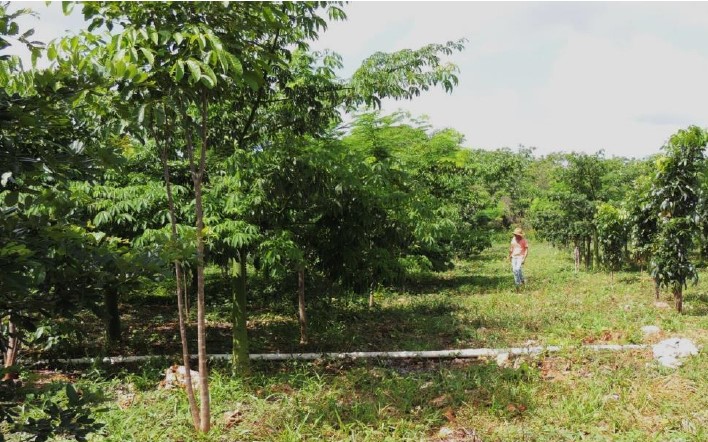
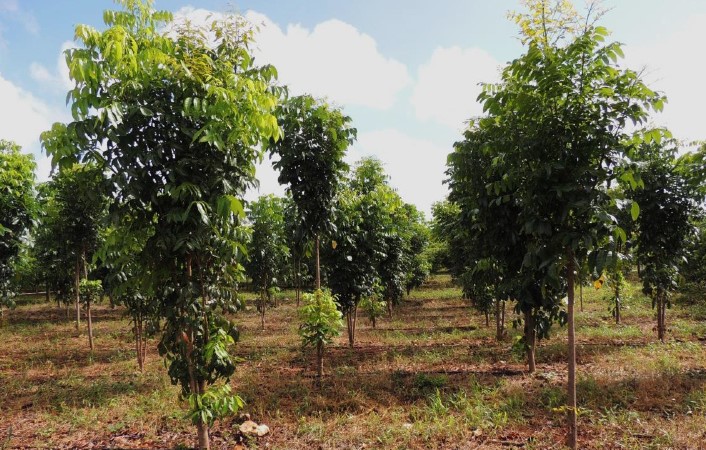
A corridor between a mixture and monoculture, and a mahogany (Swietenia macrophylla) monoculture 1.5 years after the start of the experiment (June, July 2013)
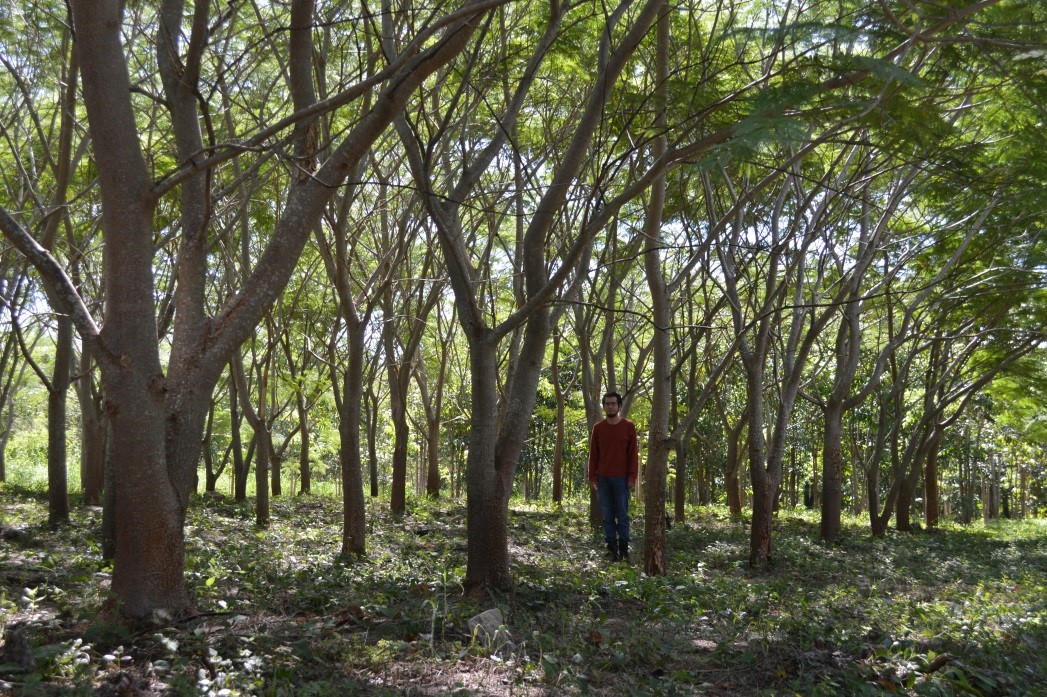
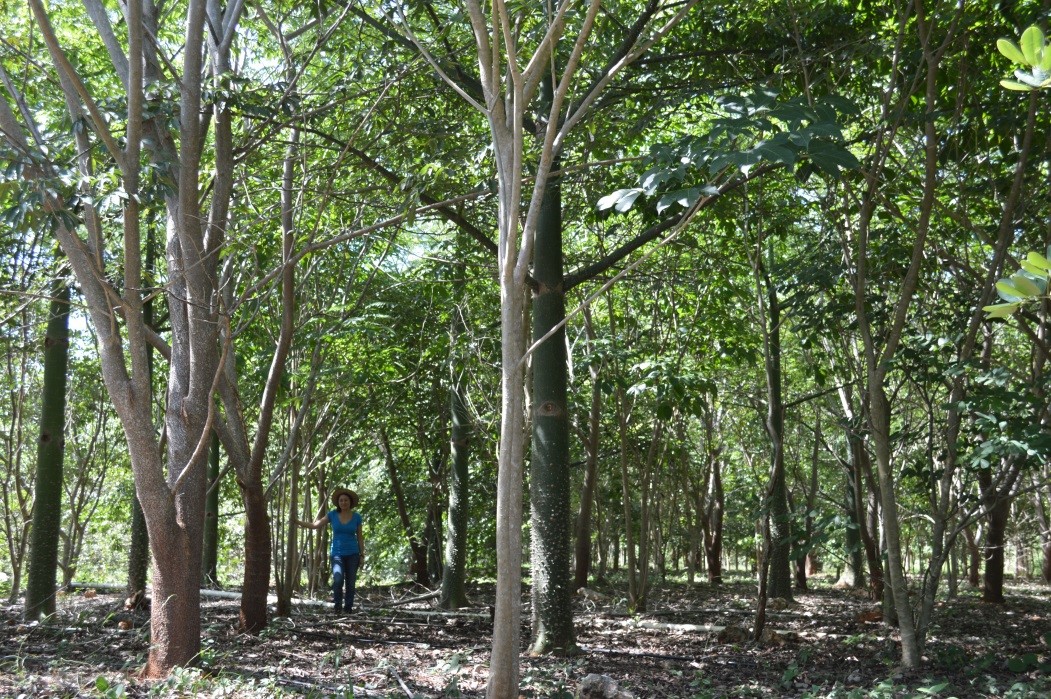
A monoculture (Enterolobium cyclocarpum) and a mixture 3.5 years after the start of the experiment, with the trees 6 to 12 m tall, depending on the species (August 2015)
